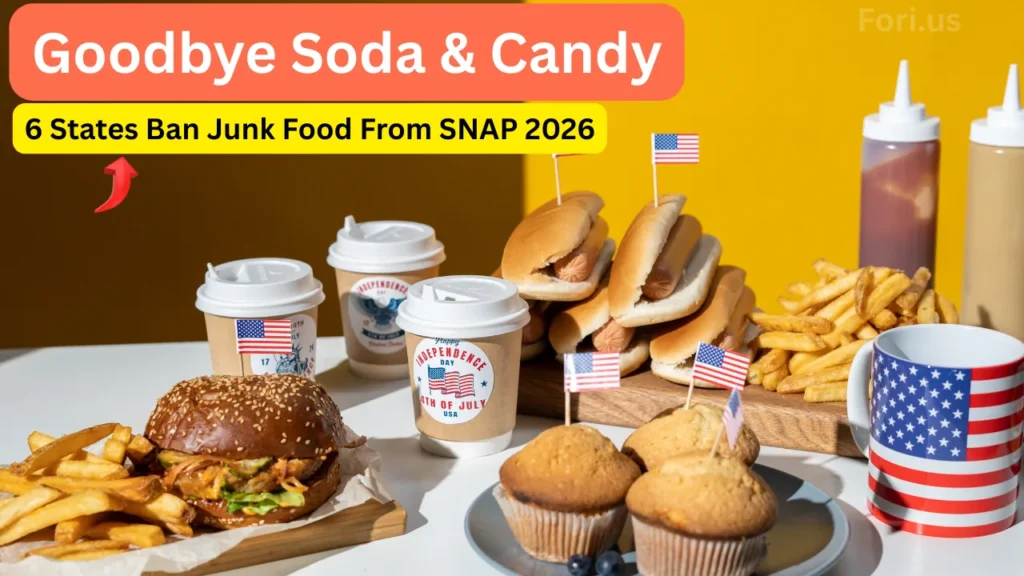The U.S. Department of Agriculture (USDA) has taken another big step toward reshaping how Supplemental Nutrition Assistance Program (SNAP) benefits are used. Six more states have now received approval to restrict the purchase of junk food items like soda, candy, and energy drinks. For millions of families relying on SNAP, this means new rules about what can and cannot be bought with benefits.
The change has been branded by many as a “Goodbye Soda” moment, marking the gradual removal of sugary drinks and processed sweets from the nation’s food assistance program. Supporters say this move promotes healthier choices, while critics warn it could limit personal freedom.
New SNAP Rules 2025-More States Ban Processed Foods

Goodbye Soda on Food Stamps: See the States and Rules
| New States Approved | Texas, Oklahoma, Louisiana, Colorado, Florida, West Virginia |
| Implementation Dates | January–April 2026 |
| Items Banned | Soda, candy, energy drinks, prepared desserts |
| States Already Approved | Arkansas, Idaho, Indiana, Iowa, Nebraska, Utah |
| Purpose | Encourage healthier eating under “Make America Healthy Again” program |
Which States Are Now Included
Six new states join the list of those restricting junk food under SNAP:
- Texas – Restrictions begin April 1, 2026
- Oklahoma – January 1, 2026
- Louisiana – January 15, 2026
- Colorado – March 1, 2026
- Florida – January 1, 2026
- West Virginia – January 1, 2026
These additions bring the total to 12 states, as six others — Arkansas, Idaho, Indiana, Iowa, Nebraska, and Utah — had already been approved earlier this year.
What Foods Are Banned Under the New Rules
The new restrictions target foods considered to have little or no nutritional value. Among the items that will no longer be eligible for purchase with SNAP benefits:
- Soda and soft drinks – including both regular and diet versions
- Candy – such as chocolate, gummies, and hard sweets
- Energy drinks – often high in both sugar and caffeine
- Prepared desserts – cakes, cookies, and pastries
These products are linked to health issues such as diabetes, obesity, and other chronic conditions. The Goodbye Soda policy aims to shift SNAP purchases toward healthier alternatives.
US Bank Closing 40 Branches Across 16 States
Why the USDA Is Making This Change
The decision is part of the “Make America Healthy Again” (MAHA) initiative, which focuses on improving nutrition among low-income households. According to the USDA, the restrictions are designed to:
- Encourage SNAP users to buy more wholesome foods
- Reduce diet-related diseases, including obesity and diabetes
- Ensure taxpayer money supports healthier choices
Advocates argue that steering families away from processed junk food will have long-term health benefits and lower healthcare costs.
Supporters vs. Opponents
Supporters believe the policy is an important step toward building healthier communities. They argue that families will now be more likely to spend benefits on items like fruits, vegetables, and whole grains.
Opponents, however, see the restrictions as limiting choice. Critics say families should be trusted to decide what to buy with their benefits. Some also note that in areas with limited grocery options, healthier foods may be harder to find or more expensive.
What SNAP Benefits Still Cover
Even with the restrictions, SNAP continues to cover a broad range of nutritious foods, including:
- Fruits and vegetables – whether fresh, frozen, or canned
- Proteins – meat, poultry, and fish
- Dairy products – milk, cheese, yogurt
- Grains – bread, rice, pasta, and cereal
- Seeds and plants – for households to grow their own produce
These items remain at the core of the program, ensuring families can still put balanced meals on the table.
The Potential Impact on Families and Retailers
The Goodbye Soda rules could bring several changes:
- Health improvements – Limiting sugary drinks and sweets may reduce obesity and related illnesses.
- Behavior shifts – Families may begin choosing healthier options when shopping.
- Retail impact – Stores might see drops in soda and candy sales but increases in healthier products.
However, opponents argue that the policy alone may not solve nutrition challenges if access to affordable healthy food remains limited in some communities.
Top Remote Jobs Paying $60+ Per Hour in 2025
Looking Ahead: More States Could Join
The USDA has left the door open for other states to adopt similar restrictions. If the program proves successful, more states may follow, eventually creating a nationwide standard. For SNAP recipients, staying updated on these changes will be important to avoid surprises at checkout and to plan grocery purchases accordingly.
FAQs About Goodbye Soda & Candy on Food Stamps
Texas, Oklahoma, Louisiana, Colorado, Florida, and West Virginia.
Soda, candy, energy drinks, and desserts such as cookies, cakes, and pastries.
To encourage healthier eating under the “Make America Healthy Again” initiative and reduce diet-related diseases.
Yes. Families can still buy fruits, vegetables, proteins, dairy, grains, and even seeds or plants to grow their own food.
Yes. The USDA is considering expanding the policy if the results in current states are positive.
The expansion of restrictions marks a clear turning point for SNAP. With six new states joining the effort, the Goodbye Soda initiative is now reshaping how millions of families spend their benefits. While debates continue about freedom of choice and access to healthy foods, the push for better nutrition is gaining momentum.
For families who depend on SNAP, the challenge will be learning to adjust shopping habits and focus on the nutritious items that remain fully covered. The broader question is whether these changes will help create lasting improvements in health for low-income households across the nation.
